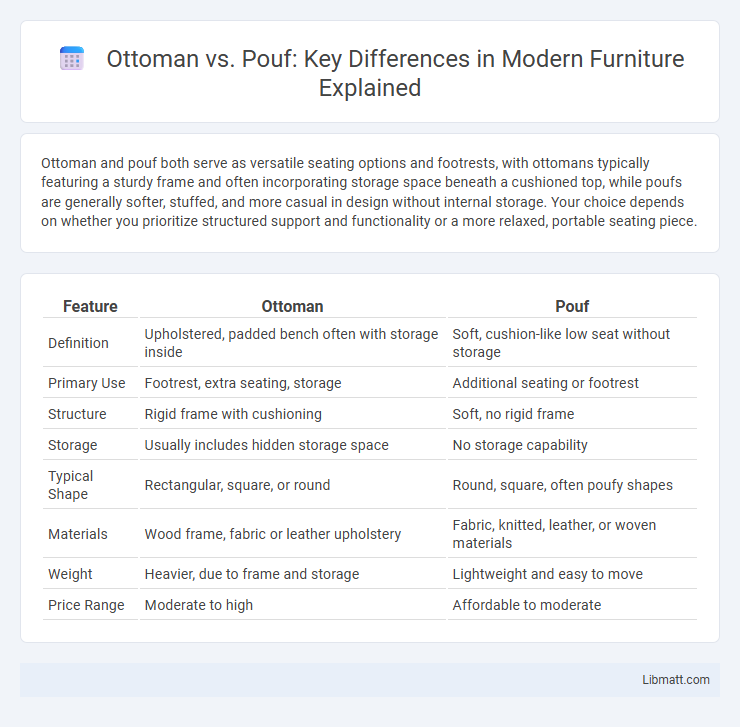Ottoman and pouf both serve as versatile seating options and footrests, with ottomans typically featuring a sturdy frame and often incorporating storage space beneath a cushioned top, while poufs are generally softer, stuffed, and more casual in design without internal storage. Your choice depends on whether you prioritize structured support and functionality or a more relaxed, portable seating piece.
Table of Comparison
| Feature | Ottoman | Pouf |
|---|---|---|
| Definition | Upholstered, padded bench often with storage inside | Soft, cushion-like low seat without storage |
| Primary Use | Footrest, extra seating, storage | Additional seating or footrest |
| Structure | Rigid frame with cushioning | Soft, no rigid frame |
| Storage | Usually includes hidden storage space | No storage capability |
| Typical Shape | Rectangular, square, or round | Round, square, often poufy shapes |
| Materials | Wood frame, fabric or leather upholstery | Fabric, knitted, leather, or woven materials |
| Weight | Heavier, due to frame and storage | Lightweight and easy to move |
| Price Range | Moderate to high | Affordable to moderate |
Ottoman vs Pouf: Key Differences
Ottomans feature a sturdy wooden frame and often include storage space, making them both functional and durable as footrests or extra seating. Poufs, typically crafted from soft, flexible materials like knitted fabric or leather, provide lightweight, portable options primarily for casual seating or decoration. The key differences lie in structure and purpose: ottomans emphasize support and storage, while poufs prioritize comfort and versatility in smaller spaces.
History and Origins of Ottomans
Ottomans, originating from the Ottoman Empire of the 14th century, were initially designed as low, upholstered footstools for comfort and practicality in homes. Unlike poufs, which have Moroccan roots and often serve decorative as well as functional purposes, Ottomans evolved as sturdy, multipurpose furniture pieces used for seating, storage, and footrests. Your space can benefit from the Ottoman's rich historical significance and versatile design, offering both heritage and utility.
The Evolution of the Pouf
The pouf evolved from the traditional Ottoman, originally designed as a simple, low seat or footrest in Middle Eastern cultures. Over centuries, its design diversified to include various shapes, sizes, and upholstery materials, adapting to modern interior aesthetics while maintaining its functional roots. Contemporary poufs often blend style and comfort, serving as versatile accent pieces in homes worldwide.
Design and Construction Variations
Ottoman and pouf designs differ primarily in structure and style, with ottomans typically featuring a wooden or metal frame offering firmness and support, while poufs are often constructed from soft, cushioned materials like knitted fabric or leather for a more flexible, casual seating solution. Ottomans usually have a boxy or rectangular shape with storage capabilities or upholstered tops, whereas poufs are round or polygonal with lightweight, fill-in materials such as beads or foam for easy movement. These construction variations cater to diverse interior design needs, with ottomans blending in as functional furniture pieces and poufs serving as versatile, decorative accents.
Functional Uses: Ottoman vs Pouf
Ottomans offer versatile functional uses such as extra seating, storage space, and a footrest, often featuring a sturdy, rectangular or square design with a hinged top. Poufs provide a lightweight, portable seating option or footrest with a softer, round shape, typically lacking built-in storage but enhancing room aesthetics. Your choice depends on whether you prioritize multifunctional furniture like an ottoman or flexible, decorative comfort from a pouf.
Material Choices and Durability
Ottomans are typically crafted using sturdy hardwood frames and high-density foam, ensuring long-lasting durability and support, while poufs often feature softer materials like cotton, leather, or knitted fabrics that prioritize comfort but may wear faster. Your choice depends on the intended use; ottomans suit heavy, everyday use with their robust construction, whereas poufs offer lightweight, flexible seating options with easy portability. Consider the material's resilience and maintenance needs to match your lifestyle and durability expectations.
Aesthetic Appeal and Style Options
Ottomans offer a sleek, versatile design that complements modern and traditional interiors, while poufs bring a casual, bohemian vibe with their soft, rounded shapes and vibrant patterns. Your choice between ottoman and pouf can enhance your room's aesthetic appeal by balancing formality and comfort, with ottomans often featuring storage and firmer surfaces, and poufs providing a cozy, laid-back seating option. Both pieces serve as functional decor, allowing customization with various fabrics, colors, and textures to match your personal style and elevate your living space.
Space-Saving and Versatility
Ottoman furniture offers significant space-saving benefits by serving multiple functions such as storage, seating, and even as a coffee table. Poufs, while also versatile, primarily occupy less floor space and provide lightweight, portable seating that can be easily moved around. Both pieces enhance room functionality but ottomans typically offer greater storage solutions, whereas poufs excel in flexibility and compactness.
Price Comparison: Ottoman vs Pouf
Ottomans typically cost more than poufs due to their larger size, sturdy frame, and added features like storage compartments or legs, with prices ranging from $100 to $600 or higher. Poufs are generally more affordable, often priced between $30 and $150, offering a lightweight and versatile seating option without the extra functionality. When choosing between an ottoman and a pouf, your budget and intended use will greatly influence the best value for your space.
Choosing the Right Piece for Your Home
Selecting between an Ottoman and a Pouf depends on your home's functional needs and aesthetic preferences; Ottomans typically offer storage options and sturdy surfaces, making them ideal for living rooms or multi-use spaces. Poufs, often smaller and more lightweight, provide versatile seating or footrests with a casual, bohemian charm suitable for cozy, informal areas. Consider the room size, intended use, and design style to choose the perfect piece that enhances both comfort and decor harmony.
Ottoman vs Pouf Infographic

 libmatt.com
libmatt.com